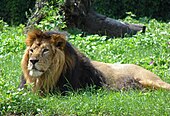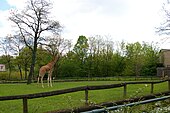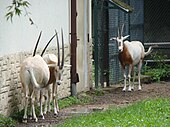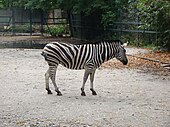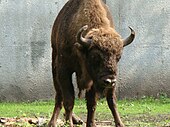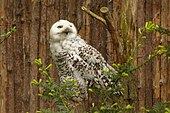Łódź Zoo
| Łódź Zoo | |
|---|---|
 The main entrance | |
 | |
| 51°45′39″N 19°24′43″E / 51.76083°N 19.41194°E | |
| Date opened | 1938 |
| Location | Łódź, Poland |
| Land area | 16 hectares (40 acres) |
| No. of animals | 2,245[1] |
| No. of species | 677[2] |
| Memberships | EAZA, WAZA |
| Director | Tomasz Jóźwik |
| Website | uml |
The Łódź Zoo (Polish: Miejski Ogród Zoologiczny w Łodzi) is a
The zoo is a member of the
History
The zoo was opened in 1938 in the Polesie district and covered the area of 8,9 hectares. In 1939, the zoo was in possession of only 50 animals such as
Since 1991, the zoo is part of the
The zoo's breeding program had a number of successes which include the births of southern cassowaries in 2014 and 2016,[6] pied tamarin in 2014[7] and lynx in 2015.[8]
In 2016, a 54-year-old elephant named Magda died in the zoo after battling an illness for two years. She was one of the oldest Indian elephants in Europe.[9]
Orientarium
In 2015, the construction of the Orientarium building started. It is the biggest investment in the history of the zoo. The whole complex will specifically feature the
In 2022, the Orientarium was officially opened. It is the most modern zoological complex devoted to South-East Asia in Europe and has become the biggest attraction of the zoo.[12] The main building has an area of 33 000 m² and consists of three levels including one underground. In 2023, the complex won Poland's top architecture prize the SARP Award of the Year.[13]
Gallery
-
Visitors watching bathing Indian elephants
-
Elephants pavilion
-
Underwater tunel
-
Griffon vulture
-
Fiji banded iguana
See also
References
- ^ "Największe ogrody zoologiczne w Polsce". Retrieved 2018-09-01.
- ^ "Największe ogrody zoologiczne w Polsce". Retrieved 2018-09-01.
- ^ "Historia ZOO". Retrieved 2018-09-01.
- ^ "Zoo w Łodzi". Retrieved 2018-09-01.
- ^ "Historia ZOO". Retrieved 2018-09-01.
- ^ "ZOO w Łodzi ma nowych mieszkańców. Wykluły się trzy kazuary hełmiaste". Retrieved 2018-09-01.
- ^ "Pierwsze w Polsce narodziny małpki tamaryny w łódzkim ZOO". Retrieved 2018-09-01.
- ^ "Zoo w Łodzi. Mały ryś nizinny ma już imię". Retrieved 2018-09-01.
- ^ Jacek Losik (24 January 2016). "Słonica Magda nie żyje. Odeszła najstarsza mieszkanka łódzkiego zoo". dzienniklodzki.pl (in Polish). Retrieved 19 May 2023.
- ^ "ORIENTARIUM". Retrieved 2018-09-01.
- ^ "Zoo w Łodzi". Retrieved 2018-09-01.
- ^ "O nas". orientarium.lodz.pl (in Polish). Retrieved 19 May 2023.
- ^ Laura Montoya (18 May 2023). "Orientarium scoops Poland's top architectural prize". thefirstnews.com. Retrieved 19 May 2023.




